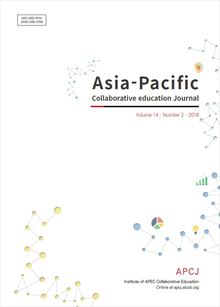간행물
Asia-Pacific Collaborative education Journal

- 발행기관 APEC국제교육협력원
- 자료유형 학술지
- 간기 반년간
- ISSN 2092-674X (Print)2092-6758 (Online)
- 수록기간 2004 ~ 2021
- 주제분류 사회과학 > 교육학 사회과학 분류의 다른 간행물
- 십진분류KDC 371DDC 379
권호리스트/논문검색
Volume 7 Number 2 (2011년 12월) 4건
1.
2011.12
구독 인증기관 무료, 개인회원 유료
This paper examines the experiences of selected academics pioneering e-learning in Malaysian tertiary institutions. It begins with an overview of the broad factors shaping the Malaysian educational environment and then proceeds to examine the experience of individual teachers and e-learning programs. It takes an in-depth qualitative approach to engaging with this case study material drawing heavily on semi-structured interviews with key actors. Conversations with several respondents suggested that the social networks of mentor relations found in the Malaysian case studies might be aptly described as ‘bamboo networks’. Bamboo, which happens to be plentiful in the Malaysian peninsula where these case studies are based, spreads from clump to clump through a series of underground connections involving a mature clump of bamboo sending out a subterranean runner, often over very long distances that then emerge into the open as a new bamboo clump. All of those interviewed reported that they have found it difficult to find a support base in their first years of pioneering online developments. Consequently, they tended to fall back on their peer networks linked to the institutions at which they had studied. Prominent individuals championing e-learning in the institutions where they teach tend to form small groups for information sharing and networking. They do look to their management for tacit ‘permission’ rather than direct encouragement. Consequently, the active promotion of e-learning in Malaysia can be described as being ‘middle-down’ rather than ‘top-down’ in nature. That is to say, it is mid-level teachers that inspire those below them to join in the development of e-learning programs. They are internally driven and strongly motivated. In time, their activity should produce new generations of locally developed e-learning experts but this has yet to take place in a substantial fashion. This study shows that both men and women ‘academic guanxi’, or peer networks, play a key role in the adoption of online technologies. Key early adopters become change-agents by inspiring a small network of their peers and via their guanxi networks. It was also discovered that motivation is not simply an individual matter but is also about groups and peer networks or communities of exchange and encouragement. In the development of e-learning in Malaysia, there is very little activity that is not linked to small clusters of developers who are tied into wider networks through personal contacts. Like clumping bamboo, whilst the local clusters tend to be easily seen, the longer-range ‘subterranean’ personal connections are generally not nearly so immediately obvious. These connections are often the product of previous mentoring relationships, including the relationships between influential teachers and their former postgraduate students. These relationships tend to work like bamboo runners: they run off in multiple directions, subterranean and unseen and then throw up new clumps that then send out fresh runners of their own.
5,100원
2.
2011.12
구독 인증기관 무료, 개인회원 유료
The purpose of this study is to present and explore current state and reform tendency of teacher education curriculum of Normal universities in China, focusing on curriculum provisions and training methods of pre-service teachers. For this purpose, the background of teacher education curriculum reform has been discussed at first from angles of society, the government and Normal Universities. It is obvious that China’s teacher education courses have attained internationally known achievements over the past decades and have supported the largest scale of basic education all over the world. The current focal problem of China’s teacher education is not the problem of teacher’s quantity, but quality. In order to adapt to the new situation and tendency, the Chinese government adjusted strategic direction and provided new guidance on teacher education for improving the quality. It includes the transformation of teacher education models from “planned training” to “market oriented control”; active support for improving teacher’s academic levels; implementation of the open-type teacher training pattern and so on. According to the government’s control and guidance, Normal Universities should also change training concepts and teacher education philosophy, mainly on enhancing quality-oriented education, emphasizing students’ sustainable self development ability, and attaching importance on the concept of lifelong education. Under this same background, teacher education universities show extreme similarity on curriculum reform. They all stick to the model of one basic training object, two elective specialty calibers for choice, three-dimensional crossed curriculum systems, four types of optional curriculums, five-in-one training patterns, and six aspects of surrounded general education courses. A lot of practice indicates that the reform of teacher education mode in universities is effective and rational to some extent. The model is worth refering to in teacher education curriculum reform, for most countries.
4,000원
3.
2011.12
구독 인증기관 무료, 개인회원 유료
4,000원
4.
2011.12
구독 인증기관 무료, 개인회원 유료
Australian teacher training universities continuously aspire to translate contemporary teacher education research findings into viable classroom teaching practice. However, much seems to be lost in the “translation.” While Australian teachers are considered to be amongst the best in the world, their reputation belies an incompatibility between modern teaching techniques and traditional approaches such as transmission and behaviorism. This paper will discuss current initiatives by the Australian Government to transform what is considered an already “quality” education system into something “better” with a newly developed national curriculum. Expectations to be placed upon Australian teachers in achieving mandates within the new national standardized curriculum will be explored.
4,000원

